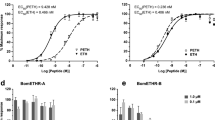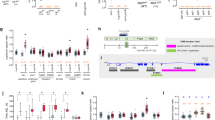Summary
At the culmination of each molt, the larval tobacco hornworm exhibits a pre-ecdysis behavior prior to shedding its old cuticle at ecdysis. Both pre-ecdysis and ecdysis behaviors are triggered by the peptide, eclosion hormone (EH). Pre-ecdysis behavior consists of rhythmic abdominal compressions that loosen the old larval cuticle. This behavior is robust at larval molts, but at the larval-pupal molt the only comparable behavior consists of rhythmic dorso-ventral flexions of the anterior body. These flexions appear to be an attenuated version of the larval pre-ecdysis behavior because (1) they show the same EH dependence, and (2) the motor patterns recorded from EH treated, deafferented larval and pupal preparations are similar except that the pupal pattern is much weaker. Both patterns are characterized by rhythmic, synaptically-driven bursts of action potentials in motoneurons MN-2 and MN-3, which occur synchronously in all segments. However, the synaptic drive to the motoneurons and their resultant levels of activity are reduced during the pupal pre-ecdysis motor pattern, especially in posterior abdominal segments. Although the dendritic arbors of both motoneurons regress somewhat during the larval-pupal transformation, this does not appear to be the primary source of diminished synaptic drive because regression is greatest in the segments in which synaptic inputs remain the strongest. The developmental weakening of the pre-ecdysis motor pattern thus may be due to changes at the interneuronal level.
Similar content being viewed by others
Abbreviations
- A2, A3...:
-
abdominal segments 2, 3, etc.
- ALE :
-
anterior lateral external muscle
- day L3 :
-
third day of the 5th larval instar
- day P0 :
-
the day of pupal ecdysis
- DN a :
-
anterior branch of the dorsal nerve
- EH :
-
eclosion hormone
- HPLC :
-
high performance liquid chromatography
- TP :
-
tergopleural muscle
References
Bacon JP, Altman JS (1977) A silver intensification method for cobalt filled neurons in whole mount preparations. Brain Res 138:359–363
Bell RA, Joachim FA (1976) Techniques for rearing laboratory colonies of tobacco hornworms and pink bollworms. Ann Entomol Soc Am 69:365–373
Bennett K, Truman JW (1985) Steroid-dependent survival of identifiable neurons in cultured ganglia of the moth Manduca sexta. Science 299:58–60
Booker R, Truman JW (1987a) Postembryonic neurogenesis in the CNS of the tobacco hornworm, Manduca sexta. I. Neuroblast arrays and the fate of their progeny during metamorphosis. J Comp Neurol 255:548–559
Booker R, Truman JW (1987b) Postembryonic neurogenesis in the CNS of the tobacco hornworm, Manduca sexta. II. Hormonal control of imaginal nest cell degeneration and differentiation during metamorphosis. J Neurosci 7:4107–4114
Brogan RT, Pitman RM (1981) Axonal regeneration in an identified insect motoneurone. J Physiol (Lond) 285:231–255
Copenhaver PF, Truman JW (1982) The role of eclosion hormone in the larval ecdyses of Manduca sexta. J Insect Physiol 28:695–701
Copenhaver PF, Truman JW (1986a) Identification of the cerebral neurosecretory cells that contain eclosion hormone in Manduca sexta. J Neurosci 6:1738–1747
Copenhaver PF, Truman JW (1986b) Control of neurosecretion in the moth Manduca sexta: physiological regulation of the eclosion hormone cells. J Comp Physiol A 158:445–455
Giebultowicz JM, Truman JW (1984) Sexual differentiation in the terminal ganglion of the moth Manduca sexta: role of sex-specific neuronal death. J Comp Neurol 226:87–95
Jacobs GA, Weeks JC (1990) Postsynaptic changes at a sensory-tomotoneuron synapse contribute to the developmental loss of a reflex behavior during insect metamorphosis. J Neurosci 10:1341–1356
Kent KS, Levine RB (1988a) Neural control of leg movements in a metamorphic insect: Persistence of the larval leg motor neurons to innervate the adult legs of Manduca sexta. J Comp Neurol 276:30–43
Kent KS, Levine RB (1988b) Reorganization of an identified leg motor neuron during metamorphosis of the moth Manduca sexta. Soc Neurosci Abstr 14:1004
Levine RB (1989) Expansion of the central arborizations of persistent sensory neurons during insect metamorphosis: the role of the steroid hormone, 20-hydroxyecdysone. J Neurosci 9:1045–1054
Levine RB, Truman JW (1982) Metamorphosis of the insect nervous system: changes in morphology and synaptic interactions of identified neurons. Nature 299:250–252
Levine RB, Truman JW (1983) Peptide activation of a simple neural circuit. Brain Res 279:335–338
Levine RB, Truman JW (1985) Dendritic reorganization of abdominal motoneurons during metamorphosis of the moth Manduca sexta. J Neurosci 5:2424–2431
Levine RB, Weeks JC (1989) Reorganization of neural circuits and behavior during insect metamorphosis. In: Carew TJ, Kelley D (eds) Perspectives on neural systems and behavior. Alan R Liss, Inc., New York, pp 195–228
Levine RB, Weeks JC (1990) Hormonally mediated changes in simple reflex circuits during metamorphosis in Manduca. J Neurobiol 21:1022–1036
Levine RB, Truman JW, Linn D, Bate CM (1986) Endocrine regulation of the form and function of axonal arbors during insect metamorphosis. J Neurosci 6:293–299
Libby JL (1959) The nervous system of certain abdominal segments of the Cecropia larva (Lepidoptera: Saturniidae). Ann Entomol Soc Am 52:469–480
Marti T, Takio K, Walsh KA, Terzi G, Truman JW (1987) Microanalysis of the amino acid sequence of the eclosion hormone from the tobacco hornworm, Manduca sexta. FEBS Lett 219:415–418
Mesce KA, Truman JW (1988) Metamorphosis of the ecdysis motor pattern in the hawkmoth Manduca sexta. J Comp Physiol A 163:287–299
Miles CI, Weeks JC (1988) Developmental changes in pre-ecdysis motor patterns of the moth, Manduca sexta. Soc Neurosci Abstr 14:988
Morton DB, Truman JW (1988) The EGPs: the eclosion hormone and cyclic GMP-regulated phosphoproteins: Appearance and partial characterization in the CNS of Manduca sexta. J Neurosci 8:1326–1337
Reynolds SE, Truman JW (1980) Eclosion hormone. In: Miller TA (ed) Insect neurohormones. Springer, Berlin Heidelberg New York, pp 196–214
Terzi G, Truman JW, Reynolds SE (1988) Purification and characterization of eclosion hormone from the moth Manduca sexta. Insect Biochem 18:701–707
Trimmer BA, Weeks JC (1989) Effects of nicotinic and muscarinic agents on an identified motoneurone and its direct afferent inputs in larval Manduca sexta. J Exp Biol 144:303–337
Truman JW (1983) Programmed cell death in the nervous system of an adult insect. J Comp Neurol 216:445–452
Truman JW (1984) The preparatory behavior rhythm of the moth Manduca sexta: an ecdysteroid-triggered circadian rhythm that is independent of the brain. J Comp Physiol A 155:521–528
Truman JW (1985) Hormonal control of ecdysis. In: Kerkut GA, Gilbert LI (eds) Comprehensive insect physiology, biochemistry, and pharmacology. Pergamon Press, Oxford, pp 413–440
Truman JW (1988) Hormonal approaches for studying nervous system development in insects. Adv Insect Physiol 21:1–34
Truman JW, Copenhaver PF (1989) The larval eclosion hormone neurones in Manduca sexta: identification of the brain-proctodeal nervous system. J Exp Biol 147:457–470
Truman JW, Reiss SE (1988) Hormonal regulation of the shape of identified motoneurons in the moth Manduca sexta. J Neurosci 8:765–775
Truman JW, Schwartz LM (1984) Steroid regulation of neuronal death in the moth nervous system. J Neurosci 4:274–280
Truman JW, Weeks JC (1985) Activation of neuronal circuits by circulating hormones in insects. In: Selverston AI (ed) Model neural networks and behavior. Plenum Press, New York, pp 381–399
Truman JW, Taghert PH, Reynolds SE (1980) Physiology of pupal ecdysis in the tobacco hornworm, Manduca sexta, I. Evidence for control by eclosion hormone. J Exp Biol 88:327–337
Weeks JC (1987) Time course of hormonal independence for developmental events in neurons and other cell types during insect metamorphosis. Dev Biol 124:163–176
Weeks JC, Ernst-Utzschneider K (1989) Respecification of larval proleg motoneurons during metamorphosis of the tobacco hornworm, Manduca sexta: segmental dependence and hormonal regulation. J Neurobiol 20:569–592
Weeks JC, Jacobs GA (1987) A reflex behavior mediated by monosynaptic connections between hair afferents and motoneurons in the larval tobacco hornworm, Manduca sexta. J Comp Physiol A 160:315–329
Weeks JC, Levine RB (1990) Postembryonic neuronal plasticity and its hormonal control during insect metamorphosis. Annu Rev Neurosci 13:183–194
Weeks JC, Truman JW (1984a) Neural organization of peptide-activated ecdysis behaviors during the metamorphosis of Manduca sexta. I. Conservation of the peristalsis motor pattern at the larval-pupal transformation. J Comp Physiol A 155:407–422
Weeks JC, Truman JW (1984b) Neural organization of peptide-activated ecdysis during the metamorphosis of Manduca sexta. II. Retention of the proleg motor pattern despite loss of the prolegs at pupation. J Comp Physiol A 155:423–433
Weeks JC, Truman JW (1985) Independent steroid control of the fates of motoneurons and their muscles during insect metamorphosis. J Neurosci 5:2290–2300
Weeks JC, Truman JW (1986a) Steroid control of neuron and muscle development during the metamorphosis of an insect. J Neurobiol 17:249–267
Weeks JC, Truman JW (1986b) Hormonally mediated reprogramming of muscles and motoneurons during the larval-pupal transformation of the tobacco hornworm, Manduca sexta. J Exp Biol 125:1–13
Wolfgang W, Riddiford LM (1987) Cuticular mechanics during larval development of the tobacco hornworm, Manduca sexta. J Exp Biol 128:19–33
Author information
Authors and Affiliations
Rights and permissions
About this article
Cite this article
Miles, C.I., Weeks, J.C. Developmental attenuation of the pre-ecdysis motor pattern in the tobacco hornworm, Manduca sexta . J Comp Physiol A 168, 179–190 (1991). https://doi.org/10.1007/BF00218410
Accepted:
Issue Date:
DOI: https://doi.org/10.1007/BF00218410




